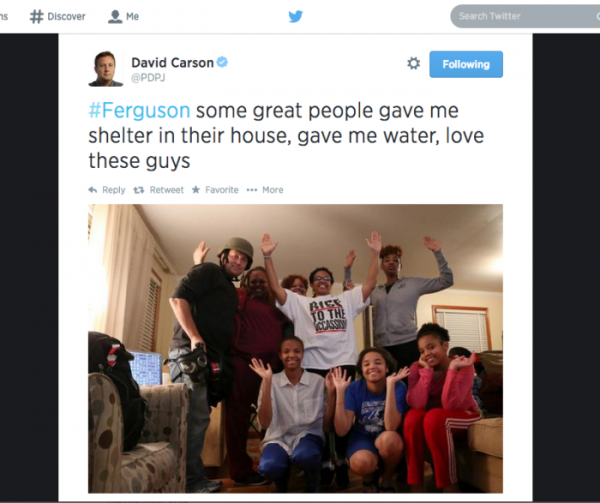From original writing by Abbey Adkison for Columbia Visuals, edited by Dan Chung:
The images of heavily militarised police in Ferguson confronting protests over the fatal shooting of 18-year-old Michael Brown by an officer have shocked the world. Even the United Nations secretary-general Ban Ki-moon has stepped in, urging law enforcement to respect international standards in dealing with demonstrations.
Journalists at the scene in Missouri have faced a double challenge. The first has been dealing with police hostility – including the arrest of veteran Getty photographer Scott Olsen on Monday.
The second has been covering the underlying story: not just filming the SWAT teams, tear gas grenades and angry exchanges, but capturing the emotions and experiences of residents.
Columbia Visuals have kindly allowed us to run extracts from their interviews with three visual journalists on the scene. For the full stories, please click through to read about the experiences of Salima Koroma, a video producer for Time, on her first out-of-state assignment; photographer David Carson, of the St. Louis Post-Dispatch; and Brent McDonald, a senior video journalist with the New York Times. Carson arrived at the scene of the 18-year-old’s death on August 10, “as the police were washing the blood off the street”, he said.
“This is history. This is something that people are going to talk to their grandkids about. It’s important to have a visual record of what actually happened here.”
Salima Koroma said that when the curfew was announced, she knew the response would be angry: “I’d been there the night before, and I could feel the frustration and hopelessness. We [the journalists] knew that something was going to happen. I didn’t expect the police tear gas; I didn’t think that they would really do it. I didn’t expect it to feel like war. I didn’t expect it to be so scary,” she said.
Koroma also noted the practical problems. She worked with a Canon 5D mkII with a Rode shotgun microphone, putting the Tascam recorder away “just because I knew I was going to be running all over the place” and trying to avoid using a light because it was “imposing” for interviewees.
She added: “I am a young, black woman. A lot of people have been a little more trusting of me, especially because I don’t have these big cameras…I’m very low-maintenance. I’m a one-man band. Whereas you have these big news organizations: a lot of them are white, a lot of them seem to not really care.
“There is a lot of distrust from protestors toward the media. When you’re talking historically, about how the media has covered African-Americans, it has not been great. Think of what the media shows of African-Americans: we are portrayed in the media as thugs, as gangsters, as poor, without talking about the root problems.”
Brent McDonald has also been travelling light: “I’m shooting with a Canon 5D MkIII that I’ve rigged out with a Zoom H6 that’s cabled line-in to the camera. Most of that video I went handheld, but sometimes I used a monopod with little feet. My Sennheiser mic is the MKE 600. I also shoot with a Audio Technica short cardioid mic.”
For him it was important to convey “what it’s like to live in this neighborhood, what it’s like to live with a police force that they didn’t trust, and was, at least this with particular officer, responsible for a pretty heinous act, if indeed it happened as witnesses describe.”
He added: “A lot of the way people cover a protest is when it gets gnarly and shit hits the fan, but there’s a whole progression to a protest when it escalates, particularly when there’s the sort of response we’ve been seeing, and it isn’t just that moment…It’s not just about people throwing bottles and police throwing tear gas, it’s about people coming out and having a voice, expressing their anger and frustration and making sense of them, respecting that.
“These are people, not sound bites.”
Like other journalists on the ground, he said his task had been made harder by law enforcement officers.
“Police did not distinguish between reporters and protestors. They threatened everyone there. They’ve threatened arrest. There were reporters who have been shot at with rubber bullets,” said McDonald.
Carson caveated that while there were police officers who had threatened him with arrest and ordered him from scenes, he had also “run into some incredibly helpful and good police officers who are certainly doing their jobs…[and are] interested in protecting me and making sure I’m safe” – just as, while some protestors were keen to see events documented, other people in the area had assaulted him.

He warned students who have asked his advice on reporting from the scene: “They’re not fooling around down here.
“I think it’s very easy to get sucked up into the excitement of it, but there’s not a picture you could make out here that would be worth being hurt for.”





